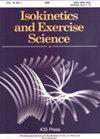柔道运动员肩旋转肌力量的横断面研究
IF 0.7
4区 医学
Q4 ENGINEERING, BIOMEDICAL
引用次数: 0
摘要
背景:柔道训练要求运动员付出很大的努力,主要集中在上肢,涉及肩部综合体。目的:比较不同经验水平(新手与高级)柔道运动员肩关节内(IR)、外(ER)旋转峰值扭矩和常规比(ER: IR),并根据ER: IR比分类验证运动员的分布。方法:39名男性柔道运动员分为两组(高龄组:20.5±2.8岁)和新手组:22.1±5.5岁)。运动员执行肩部等速运动方案来测量新手和高级组的IR和ER强度以及ER: IR比率。采用卡方检验考察运动员按不同组ER: IR比值分类的分布情况,采用t检验比较新手组和高级组之间IR、ER峰值扭矩和ER: IR比值,显著性水平设为5%。结果:主要结果显示:高级组IR峰值扭矩(77.3±15.7 N·m)高于新手组(48.2±8.4 N·m);p= 0.013),高级运动员的ER: IR比新手低(高级运动员0.63±0.1比新手0.73±0.2;p = 0.01)。当个体值分析时,高水平运动员的ER: IR比高于新手(p= 0.023)(< 0.66)。结论:与新手相比,高水平运动员肩IR峰值扭矩更高,但ER: IR比例失衡程度更高,这可能是由于长期训练导致IR强度增加,但ER强度没有相应的提高。教练和力量训练师应该监测柔道运动员的肩旋肌力量,以避免该区域的肌肉不平衡,这在柔道训练中经常使用。本文章由计算机程序翻译,如有差异,请以英文原文为准。
Shoulder rotator strength in judo athletes: A cross-sectional study with different experience levels
BACKGROUND: Judo practice requires high effort from athletes, mainly focused on the upper limbs, involving the shoulder complex. OBJECTIVE: To compare the shoulder internal (IR) and external (ER) rotation peak torque and conventional ratio (ER: IR) between judo athletes from different experience levels (novice vs. advanced) and to verify the distribution of athletes according to the ER: IR ratio classification. METHODS: Thirty-nine male judo athletes were divided into two groups (advanced: 20.5 ± 2.8 years and novice: 22.1 ± 5.5 years). The athletes performed a shoulder isokinetic protocol to measure IR and ER strength and the ER: IR ratio in novice and advanced groups. Chi-square tests were used to investigate the distribution of athletes according to the different groups of ER: IR ratio classification, and t-tests were used to compare the IR and ER peak torque and the ER: IR ratio between novice and advanced groups, with the level of significance set at 5%. RESULTS: The main results showed higher values of IR peak torque (77.3 ± 15.7 N⋅m in advanced vs. 48.2 ± 8.4 N⋅m in novices; p= 0.013), and a lower ER: IR conventional ratio in advanced athletes compared to novices (0.63 ± 0.1 advanced vs. 0.73± 0.2 in novice; p= 0.01). When individual values were analyzed, advanced athletes presented higher imbalance (< 0.66 ER: IR ratio) than novices (p= 0.023). CONCLUSION: Advanced athletes presented higher shoulder IR peak torque, but higher imbalance in the ER: IR ratio than novices, probably because the long-term training induced an increase in IR strength without concomitant development in ER strength. Coaches and strength and conditioning trainers should monitor shoulder rotator strength in judo athletes to avoid muscle imbalances in this region, which is frequently employed in judo training routines.
求助全文
通过发布文献求助,成功后即可免费获取论文全文。
去求助
来源期刊

Isokinetics and Exercise Science
医学-工程:生物医学
CiteScore
1.20
自引率
14.30%
发文量
37
审稿时长
>12 weeks
期刊介绍:
Isokinetics and Exercise Science (IES) is an international journal devoted to the study of theoretical and applied aspects of human muscle performance. Since isokinetic dynamometry constitutes the major tool in this area, the journal takes a particular interest in exploring the considerable potential of this technology.
IES publishes studies associated with the methodology of muscle performance especially with respect to the issues of reproducibility and validity of testing, description of normal and pathological mechanical parameters which are derivable from muscle testing, applications in basic research topics such as motor learning paradigms and electromyography. The journal also publishes studies on applications in clinical settings and technical aspects of the various measurement systems employed in human muscle performance research.
The journal welcomes submissions in the form of research papers, reviews, case studies and technical reports from professionals in the fields of sports medicine, orthopaedic and neurological rehabilitation and exercise physiology.
 求助内容:
求助内容: 应助结果提醒方式:
应助结果提醒方式:


